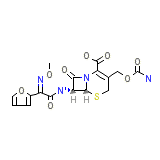Cefuroxime




Cefuroxime Brand names, Cefuroxime Analogs
- Ancef
- Biofuroksym
- Ceclor
- Ceclor CD
- Cedax
- Cefditoren
- Cefizox
- Cefobid
- Cefotan
- Ceftin
- Cefurax
- Cefuril
- Cefuroxim
- Cefuroxime [USAN:BAN:INN]
- Cefuroximo [INN-Spanish]
- Cefuroximum [INN-Latin]
- Cefzil
- Cepazine
- Cephuroxime
- Ceptaz
- Duricef
- Elobact
- Fortaz
- Keflex
- Keftab
- Kefurox
- Kefzol
- Kerurox
- Mandol
- Maxipime
- Mefoxin
- Monocid
- Omnicef
- Oraxim
- Rocephin
- Sharox
- Tazicef
- Vantin
- Velosef
- Zinacef
- Zinacef Danmark
- Zinat
- Zinnat
Cefuroxime Brand Names Mixture
- No information avaliable
Cefuroxime Chemical_Formula
Cefuroxime RX_link
Cefuroxime fda sheet
Cefuroxime msds (material safety sheet)
Cefuroxime Synthesis Reference
Cefuroxime Molecular Weight
Cefuroxime Melting Point
Cefuroxime H2O Solubility
Cefuroxime State
Cefuroxime LogP
Cefuroxime Dosage Forms
Cefuroxime Indication
Cefuroxime Pharmacology
Cefuroxime Absorption
Cefuroxime side effects and Toxicity
Cefuroxime Patient Information
Patients should be counseled that antibacterial drugs including Cefuroxime for Injection USP and Dextrose Injection USP should only be used to treat bacterial infections. They do not treat viral infections (e.g., the common cold). When Cefuroxime for Injection USP and Dextrose Injection USP is prescribed to treat a bacterial infection, patients should be told that although it is common to feel better early in the course of therapy, the medication should be taken exactly as directed. Skipping doses or not completing the full course of therapy may (1) decrease the effectiveness of the immediate treatment and (2) increase the likelihood that bacteria will develop resistance and will not be treatable by Cefuroxime for Injection USP and Dextrose Injection USP or other antibacterial drugs in the future.














